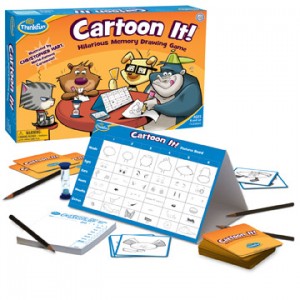Cartoon It! A Fun Drawing Game for Kids

I will not lie up front. I am a horrible artist. Awful. Always have been and I think I always will be. Though I can be creative in my job in different ways and I have other special talents where I’m more athletic in nature, I do think some people are just not blessed with drawing ability. I was so psyched when I recently found the game Morphology which uses actual objects to create pictures, because though I have enjoyed playing Pictionary with family and friends, I often wonder if anyone will be able to quickly decipher my horrible scribbles.
When Thinkfun contacted me to review their memory game Cartoon It! I was really curious to see how the children I work with would like it, since any type of drawing that’s challenging can prompt some type of forward flopping on the table, or pleas to play a different game. Just like I know I’m a horrible artist, kids know their strengths and weaknesses, too.
So many children have difficulty paying attention to small details that they do not deem relevant and this game has been so great at really encouraging kids to look at and remember minor details. This type of attention is really helpful for older children so they can learn to edit and proofread their written work, such as comparing a rough draft to a final draft. It also helps them to develop strategies to assist their memory. Some children will talk out loud about the features, others will use their fingers to trace the card and then look back at the features board to assign a sequence to help their memory. Either way, despite whether kids have a basic drawing ability or not, all of them have been successful with this game and request to play it each week, or multiple rounds in a row. I myself was only able to get 3 or 4 out of the possible 6 points when I first began playing the game, so it’s a great family game as well. To take the game even further, we have even used the character cards and drawings to develop stories featuring their character, by also giving them names, occupations and interests.
ThinkFun provided this game free to facilitate this review. The opinions are my own.